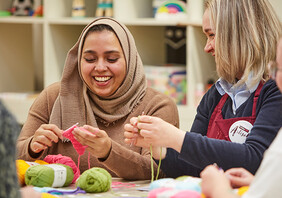How to Make a Felted Dinosaur
Make yourself a fun felted friend with this fantastic felted dinosaur project! It's an ideal project for beginners to felting, so if you've always fancied giving it a go, this is a great one to start on.
This tutorial is for beginners to needle-felting and will teach you the basic skills you need in order to create a 100% wool sculpture or toy.
You will need
How to make
We're going to make this dinosaur in separate pieces to be constructed. I like to work in this way as it allows for more control in shaping the wool. It's also a nice way of breaking down what can be quite overwhelming shapes into simpler forms.
I've used three shades of green to make my dinosaur. A light green, mid green and a dark green. A core wool or wool batting is great for this kind of project.
Begin by making the body. Pull off equal measures of dark green and mid green wool. Tease the fibres apart with your fingers, mix them and repeat until there are no obvious stripes of any one colour and the wool looks mottled.
Bundle your wool mixture into a rough ball shape and start stabbing at it with the felting needles. Work systematically around all sides. You'll notice that a big bundle of wool soon becomes a lot smaller as it's repeatedly stabbed. As you stab the wool with the felting needles you should notice that the areas stabbed are the areas that become most shaped.
Continuously rotate your work so that you can stab all areas evenly. Don't forget to stab the ends too! Use the whole length of the felting needles and work through the centre of the wool to create a solid core that is roughly lemon shaped. This stage takes a little while but it is worth making as solid a core as possible as this will be what supports the neck and the tail.

Refer to the template provided for an idea of proportion and size. If you need make the body bigger or wider simply add more wool roving evenly to the surface and stab into place.

To make the neck, roll the wool into a long sausage shape and stab all over evenly. You are aiming for along blunt shape. Keep one end unworked and fluffy.

To create 'S' shaped curves in the neck gently bend the sausage at the point you wish the curve to be and stab repeatedly directly into it. Resume stabbing all over and rotating whilst holding the curve in position. As the wool tightens up it should hold its shape.

Add more of your wool to mix to the base of the neck to make it look more muscular.
For the legs, blend equal amounts of the mid and dark green wool. Mix a large batch bit by bit as making the legs does use quite a bit of roving. Make all four legs at the same time to ensure they're a similar size.
Separate off four equal sized portions of wool, roll the into short stubby sausage shapes and stab them all over, rotating as you go. Leave one end of the sausages fluffy and unworked.

Create a club shaped foot by adding wool to the very ends of the legs.
To add length or width to the legs add small pieces of wool bit by bit. Make sure the legs are well needle felted, firm and solid. It's easier to do this before attaching them to the body.
To make the tail, make another mixture of the dark green, mid green and light green. Roll into a sausage shape and needle felt it till it becomes firmer. If you need to add length or width at any point simply add more wool roving to the area you wish to change and stab evenly into place.
Roll into a tight sausage shape using the template as a guide and stab all over to tighten and solidify but leave one end fluffy. Before the wool becomes completely solid, you may want to add extra curves to the tail in the same way as you did with the neck.

You should now have four legs, One neck and head and one tail…all ready to construct into a dinosaur! Before constructing, make sure all your pieces are well worked and solid as this will save a lot of hard work later down the line.
Position the neck and head piece onto one end of the 'lemon' shaped body. Stab the loose wool of the neck joint into the core. Work the needle deeply into the wool so that the two pieces are thoroughly joined and there is little give. Keep rotating as you work and stab evenly.
Do the same for the tail. I like to have the angle of my neck and tail going off indifferent directions, as I find it gives the dinosaur a bit more stature and balance.

You'll soon notice that harsh edges become apparent where the three body parts have been joined. Fill these joins and crevices with more wool roving. Aim to create a nice smooth streamlined curve to where the body parts join.
You should now have half a dinosaur! At this point there shouldn't be any visible sign of any joins between the three pieces and the body should be smooth and solid.

I've used blue embroidery thread to create the toes of my dinosaur but you could use any colour you fancy. Tie a knot in the end of your thread and using a sewing needle, stitch from the underside of the foot up vertically and back out through the leg. Repeat this again to create a neat vertical stitch that resembles a toe.

Stitch back through the first hole and out to one side so as to start on the second toe.
When you have applied a couple of vertical stitches for the second toe, come in from the bottom of the foot and out to a point of equal distance from the previous two toes. Try and keep your work looking neat and even.
Finish the stitching by making a tiny stitch on the underside of the foot and tying off the thread.

I find it useful to use pins when arranging this many legs onto a body! I can then move them around until I'm happy with their positioning. When you're happy with how the legs are positioned, begin to tack them into place with your felting needles.
Please refer to the attached diagram. Arrange the loose woolen ends of the legs at the angles illustrated in the diagram. This is how reptile legs bend and it will make your dinosaur look more realistic. Add small amounts of wool roving to disguise any harsh joins.

To create the stripy camouflage skin of the dinosaur add very small, fine amounts of the light green wool in a striped pattern across the dinosaurs back, base of the tail and base of the neck.

To add dots to the back, pull off tiny tufts of a muted blue wool roving. Roll it between your fingers to make a small round ball. If you wish to make equally sized dots, make several of them at the same time. Tack the dots into position and in a streamlined and even line across the length of the body. Make sure both sides are symmetrical.

With only one needle, stab a small dent into both sides of the head at the points you wish the eyes to sit. At this point it is not the head your shaping but instead creating an indentation in which the eye can nestle.
Use a sharp pair of embroidery scissors to cut a small incision. This looks vicious but it's necessary to create space for the metal wire on the back of the eyes and so that the glass eyes will sit flush.

Knot one end of your green embroidery thread and draw it through the incision from one side of the head through to the other side.
Thread the glass eye wire onto the sewing needle and then stitch back through to the other side, pulling the thread tightly.

Thread the second glass eye onto the sewing needle and stitch back through to the other side again, pulling the thread tightly. Tie off the thread securely under the glass eye so that it remains hidden.


















